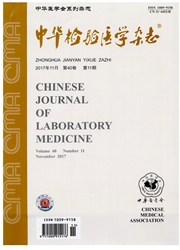

 中文摘要:
中文摘要:
目的动态观察肝衰竭患者外周血Treg细胞在人工肝治疗和内科治疗前后的水平变化规律,探讨其与疗效及预后的相关性。方法63例肝衰竭患者按治疗方式不同分为两组,29例为人工肝结合内科治疗组,34例为内科治疗组,依据肝功能、临床症状等指标判定人工肝治疗有效组17例、无效组12例,内科治疗有效组11例、无效组23例,23例健康献血员为健康对照组。流式细胞仪检测外周血Treg细胞水平,动态观察Treg细胞水平变化规律并分析与疗效的相关性。结果健康对照组Treg细胞水平(2.46±0.56)%,有效患者治疗前Treg细胞水平低于健康对照组,其中人工肝有效组(1.92±0.78)%,内科有效组(2.10±0.56)%,两组之间比较差异无统计学意义(P〉0.05),与健康对照组比较差异均有统计学意义(均P〈0.05);治疗后人工肝组(2.62±0.67)%,内科组(2.89±0.72)%,两组之间比较差异无统计学意义(P〉0.05),与健康对照组比较差异均无统计学意义(均P〉0.05);两组有效患者治疗前与治疗后比较差异均有统计学意义(均P〈0.05);无效患者治疗前Treg细胞水平高于健康对照组水平,其中人工肝组(4.64±1.31)%,内科组(4.87±2.86)%,两组之间比较差异无统计学意义(P〉0.05),与健康对照组比较差异均有统计学意义(均P〈0.05);治疗后人工肝组(5.44±2.13)%,内科组(5.91±2.78)%,两组之间比较差异无统计学意义(P〉0.05),与健康对照组比较差异均有统计学意义(均P〈0.05),两组无效患者治疗前与治疗后比较差异均有统计学意义(均P〈0.05)。Treg细胞水平变化在有效患者呈现低→高→低的“峰”形曲线,且人工肝组较内科组Treg细胞水平较早恢复至正常水平;而在无效患者呈现高→低→高的“谷”形?
 英文摘要:
英文摘要:
Objective To observe dynamically the level of CD4^+ CD25^+ Tregs in the peripheral blood in patients with liver failure receiving artificial liver support system and/or medical treatment and investigate the relationship between the level of CD4^+ CD25^+ Tregs and curative effect and prognosis. Methods Sixty-three patients with liver failure were divided into 2 groups according to the treatment protocol: medical treatment combined with artificial liver support system (combined group) (29 cases) and medical treatment only group ( medical group) (34 cases). According to indicators such as liver function and clinical symptoms etc, there were 17 effective cases and 12 ineffective cases in the combined group while 11 effective cases and 23 ineffective cases in the medical group. 23 healthy donors were used as normal control group. The level of CD4^+ CD25^+ Treg in the peripheral blood was measured by flow cytometry dynamically and the relationship between the level of CD4^+ CD25^+ Treg and curative effect was analyzed accordingly. Results The Treg level was (2. 46 ± 0. 56 )% in the normal control group. For those effective groups, the Treg level before treatment was lower compared to normal control group, it was ( 1.92 ± 0. 78 ) % and ( 2. 10 ± 0. 56 ) % in combined group and medical group respectively. There was no significant difference between these two groups (P 〉0.05) although it was statistically significant when beth compared to the normal control group (P 〈 0. 05 ) ; After treatment, the Treg level in the effective groups was (2. 62 ± 0. 67 ) % ( combined group) and (2. 89 ± 0. 72) % (medical group) respectively. There was significant difference between these two groups (P 〉 0. 05 ) while no statistical significant was found when compared to the normal control group ( P 〈 0. 05 ) ; Both effective groups showed significant difference before and after the treatment (P 〈 0. 05 ) ; As to the ineffective groups, the Treg
 同期刊论文项目
同期刊论文项目
 同项目期刊论文
同项目期刊论文
 期刊信息
期刊信息
